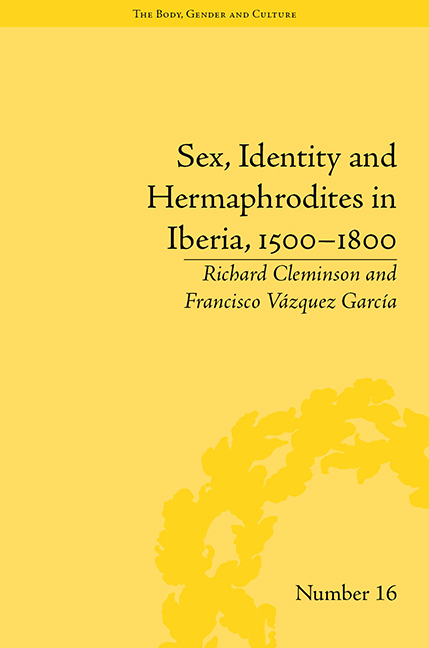Book contents
- Frontmatter
- CONTENTS
- Acknowledgements
- Introduction: Sex, Gender and Historicity
- 1 Marvels, Monsters and Prodigies: Hermaphrodites as Natural Phenomena in Spain, 1500–1700
- 2 Sexual Transgression and Hermaphroditism: The ‘New World’ and Imperial Subjectivity
- 3 The Expulsion of the Marvellous: The Decline of the ‘One-Sex’ Model, 1750–1830
- 4 Hermaphroditism in Portugal
- Conclusion
- Notes
- Works Cited
- Index
1 - Marvels, Monsters and Prodigies: Hermaphrodites as Natural Phenomena in Spain, 1500–1700
- Frontmatter
- CONTENTS
- Acknowledgements
- Introduction: Sex, Gender and Historicity
- 1 Marvels, Monsters and Prodigies: Hermaphrodites as Natural Phenomena in Spain, 1500–1700
- 2 Sexual Transgression and Hermaphroditism: The ‘New World’ and Imperial Subjectivity
- 3 The Expulsion of the Marvellous: The Decline of the ‘One-Sex’ Model, 1750–1830
- 4 Hermaphroditism in Portugal
- Conclusion
- Notes
- Works Cited
- Index
Summary
In this chapter, we illustrate how the notions of Nature, mirabilia and marvels were played out in considerations of sex, sex change and hermaphroditism in Spanish culture in the sixteenth and seventeenth centuries. Crucial to our argument is the elaboration of the working of the ‘one-sex’ model as understood by Laqueur and the overlapping and on occasion competing theories of Galen, Aristotle and Hippocrates in order to explain these phenomena. In the next chapter, we will provide an overview of how the notion of the ‘true rank’ was supplanted by the medical category of the ‘true sex’ in the nineteenth century.
Mirabilia
The category mirabilia designated extraordinary beings and events, ‘marvels’ that showed the omnipotence and inscrutability of divine design. This tradition stretches back to the Augustinian text De Civitate Dei, and was followed by Saint Isidore's Etymologies. Portents are not necessarily counter-natural beings or isolated cases with no significance; they are natural rarities that always have their analogies in the Universe. The Universe is conceived as a dense network of relations which reveal a hidden harmony, known by God but of which humans are ignorant. Because of this ignorance, humans perceive these figures as disconcerting and horrific.
It has been argued, only partly successfully, that in the later medieval period, as a result of the social and cultural crisis that took place in the fourteenth century in the wake of plagues, massacres and famines, the belief in the harmony of the Universe was undermined.
- Type
- Chapter
- Information
- Sex, Identity and Hermaphrodites in Iberia, 1500–1800 , pp. 11 - 40Publisher: Pickering & ChattoFirst published in: 2014



